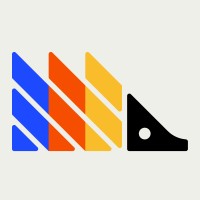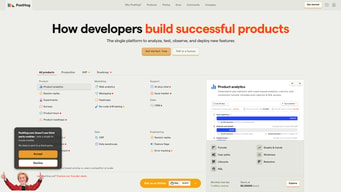

( 416 )
Unclaimed: Are are working at PostHog ?
PostHog Reviews & Product Details
PostHog is an open-source analytics platform designed to help software teams understand user behavior, improve products, and drive growth. It offers a suite of tools for event tracking, heatmaps, session recording, and feature flags, enabling developers and product managers to gain insights into how users interact with their applications.
PostHog is also often used as Product Analytics of choice in Indie Hacker and Product Management tech stacks.

( 1 )
| Capabilities |
|
|---|---|
| Segment |
|
| Deployment | Cloud / SaaS / Web-Based, On-Premise Linux |
| Training | Documentation |
| Languages | English |


Compare PostHog with other popular tools in the same category.

It's OSS, very intuitive too. We integrated it in few lines, and right after deploying it worked. It's become our dashboard for everything.
the sql mapping is not really intuitive, it does not autocomplete the data i know it's there
We can track usage without being creepy, allowing anonymous users too.
Autocapture has been such a game changer for our company. With other tracking products, we'd have to work out what we wanted to track upfront, and whenever that changed. We'd have to wait weeks for data to catch up once we add a new tracking event. Autocapture with retroactive event defining has been such a big improvement for us.
Wish that session replays were available on Android too.
We found a lot of other analytic platforms really clunky and cumbersome. Posthog just makes everything easy and helps us surface the insights we need, without hassle. A lot of our Posthog usage is understanding how people find our site, and then monitoring their progress through our signup -> onboarding -> conversion funnel. Being able to quickly visualise these funnels has really helped us work out what parts need optimising and different approaches.
PostHog is easy to add to any project - even ridiculously old ones that could benefit from some modernization. Not to mention, the setup, handling, and documentation are stupid simple. Any dev (including newbies) should have the ability to easily implmenet this into any project they need. I haven't gotten into all the features yet, but love the ones I have tried.
The only concern I currently have with PostHog is longevity, but kinda doubt it's gonna fall away anytime soon.
We need to test new features with subsets of users, and this implementation makes it easy.
Insights are easy to surface on your own as an engineer. We use feature flags and experiments to help us roll out features confidently, and the way Posthog combines both of those products is incredible. And the integrations with Segment has made Posthog super easy for us to adopt in our product.
We've noticed some issues with how the web SDK loads flags—but we're hoping those will get resolved soon
Posthog is huge for us as a startup. We use it for launching features with feature flags and experiments. Cohorts and it's own query language, HogQL, make it easy to target the right users. And we heavy use of dashboards and the Slack integrations to get everyone on our team visibility into what's happening with our product.
I like that PostHog is an open source project and has all tools in one place: recordings, analytics, and funnels.
I think the UI could be a bit simpler, e.g. Mixpanel has much simpler UI which helps non-tech people onboard faster.
We understand our users better and can react faster to user-facing issues.
Dashboard Templates seem to be the best feature. I'd bring them up-front though, and not keep it hidden.
No dislikes as such but a nicer onboarding experience would be cool.
Mostly helps us with understanding the kind of traffic we're getting + user behaviour.
As a Product Designer it's great being able to replay sessions and see what my users are doing. The implementation is super easy to learn, and gives me plenty of information. It didn't take a lot of time for my engineers to setup, and integrates nicely with our process.
Nothing I've found so far. It's been really great.
I need to understand what my users are doing and where they're finding my product experience difficult, as well as easily identifying potential issues.
They provide good quality recordings of our platform, so the Customer Support can verify user activities.
Sometimes it's hard to find your desired recording, but mostly all is fine.
To replay what happened on customer account and understand better how to solve problem for the customer case.
PostHog makes it easy to understand the performance of your product and business with highly customisable dashboards. It's easy to implement in your product with SDKs is available in most languages, and connections to customer data platforms (CDPs) like Segment. It also offers value-added features that competitors would make you pay for as separate products, like A/B testing and feature flagging.
In my experience, even with relatively small amounts of data, it can take a long time for the widgets on dashboards to load. This means that the experience of exploring my data with PostHog isn't quite "as smooth as butter"!
PostHog is helping my business to understand customer behaviour, so that I can make the right decisions about where I invest to have a more successful, engaging and well-monetised product. I can understand the impact of changes I'm making on performance (for example, are my daily active users [DAUs] increasing or reducing over time?) and understand where customers are dropping off in certain flows.
Like many other analytics tools, there is a steep learning curve to get going. That being said however, Posthogs live viewer makes it super easy to define events, and set up insights. Really handy tool to gather product and UX improvement areas. Their customer service is fantastic too - they have a designated Slack space for the community where you can ask CC questions and usually get personal help and advice within a matter of a few hours.
It can be a little confusing understanding how to get the insight set up that you are after. Easy enough to defin ethe event, but assinging it to an insight can be a little tricky. They do have a lot of learning resources though, so not the end of the world.
It is allowing our teams to track the impact of feature releases, as well as identify areas of improvement and further research
